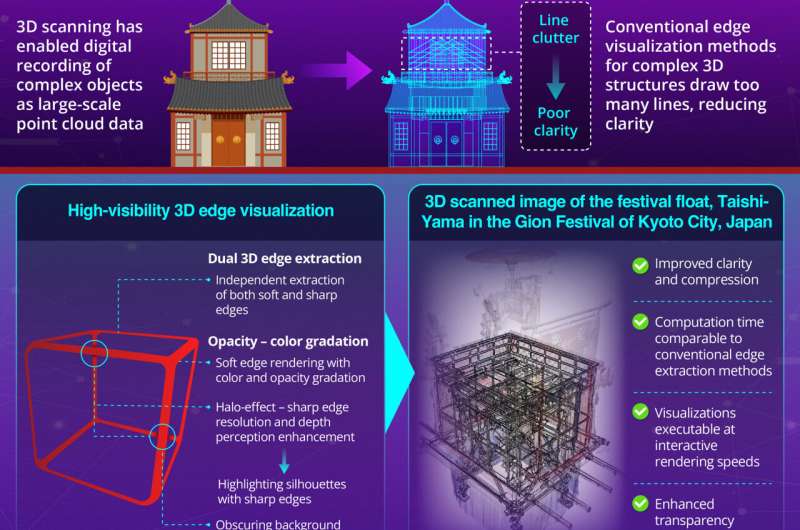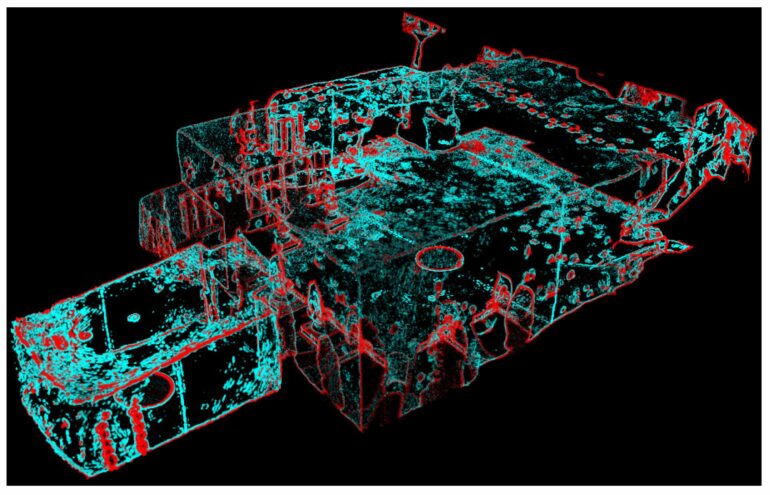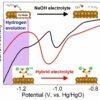Recent advances in three-dimensional (3D) scanning, particularly in photogrammetry and laser scanning, have made it possible to quickly and accurately scan complex 3D objects in the real world. These techniques generate detailed models by collecting large-scale point cloud data, representing the object’s surface geometry through millions of individual points.
This technology has applications in different fields, such as the 3D scanning of cultural heritage objects. By preserving these objects in digital formats, researchers can analyze their structures in greater depth. However, the complexity of data is often significant, especially when the scanned object has internal 3D structures, like rough edges.
Edge-highlighting visualization is a technique used to improve the clarity of complex 3D structures by emphasizing the object’s edges, making its shape and structure more distinguishable. However, existing methods struggle when applied to highly complex objects. These methods draw too many lines, which decreases clarity by impairing resolution and depth perception.
To address these challenges, a multinational team of researchers, led by Professor Satoshi Tanaka, along with colleagues Ms. Yuri Yamada, Dr. Satoshi Takatori, and Prof. Liang Li from the College of Information Science and Engineering at Ritsumeikan University, have developed an innovative method.
Elaborating on their study, Prof. Tanaka explains, “Conventional methods for extracting and visualizing 3D edges mainly concentrate on sharp edges. However, many real-world objects contain numerous soft edges in addition to sharp edges, which are inadequately represented. Our method introduces two key innovations: dual 3D edge extraction, which separately extracts both soft and sharp edges, and opacity–color gradation, which enhances the clarity of soft edges through variations in color and opacity.” These findings were published in Remote Sensing on October 9, 2024.

The proposed technique employs two novel approaches: dual 3D edge extraction and opacity–color gradation, to enhance the clarity of 3D scanned objects. © Ritsumeikan University
This novel visualization method is based on dual-edge 3D edge extraction and opacity–color gradation. Dual-edge 3D extraction technique independently processes the sharp and soft edges of a 3D object by utilizing two different feature value thresholds for sharp and soft edges. Meanwhile, the opacity–color gradation technique applies simultaneous gradation of both opacity and color to soft edges. This process renders soft edges with sharper and thinner lines, effectively highlighting the complex and intricate details of 3D structures.
Additionally, it introduces a “halo effect” that partially hides edges in the background of the image, significantly enhancing depth perception. This effect also improves the resolution of sharp edges by highlighting their silhouettes with soft edges.
The researchers tested this technique by applying it to real 3D point cloud data, including cultural heritage objects with high cultural value. Results revealed that the proposed edge-highlighting visualization technique produces a clear, comprehensible representation of the entire 3D structure.
Remarkably, the computation time required for dual-edge 3D extraction is comparable to conventional binary statistical edge extraction methods, while visualizations in opacity–color gradation are executable at interactive rendering speeds. Furthermore, this technique offers a more effective “see-through” effect, replacing the conventional transparent visualization used to study internal structures of 3D objects. Additionally, applying this technique to conventional transparent visualization is effective as well.
“Our 3D edge extraction approach is not merely an improvement but rather an extended technique that captures areas not covered by traditional methods. For archaeologists and historians, this tool opens new possibilities for specialized visual analysis of cultural heritage objects. For the general public, it offers a deeper understanding of historical cultural sites, serving as a technology for enhancing exhibitions in museums and art galleries,” says Prof. Tanaka about the potential of their research.
This innovative technique significantly advances the visualization of 3D scanned objects, promoting a better understanding and preservation of cultural heritage objects.
More information:
Yuri Yamada et al, High-Visibility Edge-Highlighting Visualization of 3D Scanned Point Clouds Based on Dual 3D Edge Extraction, Remote Sensing (2024). DOI: 10.3390/rs16193750
Provided by
Ritsumeikan University
Citation:
Boosting clarity and depth perception for complex structures with 3D object scanning (2024, October 28)



